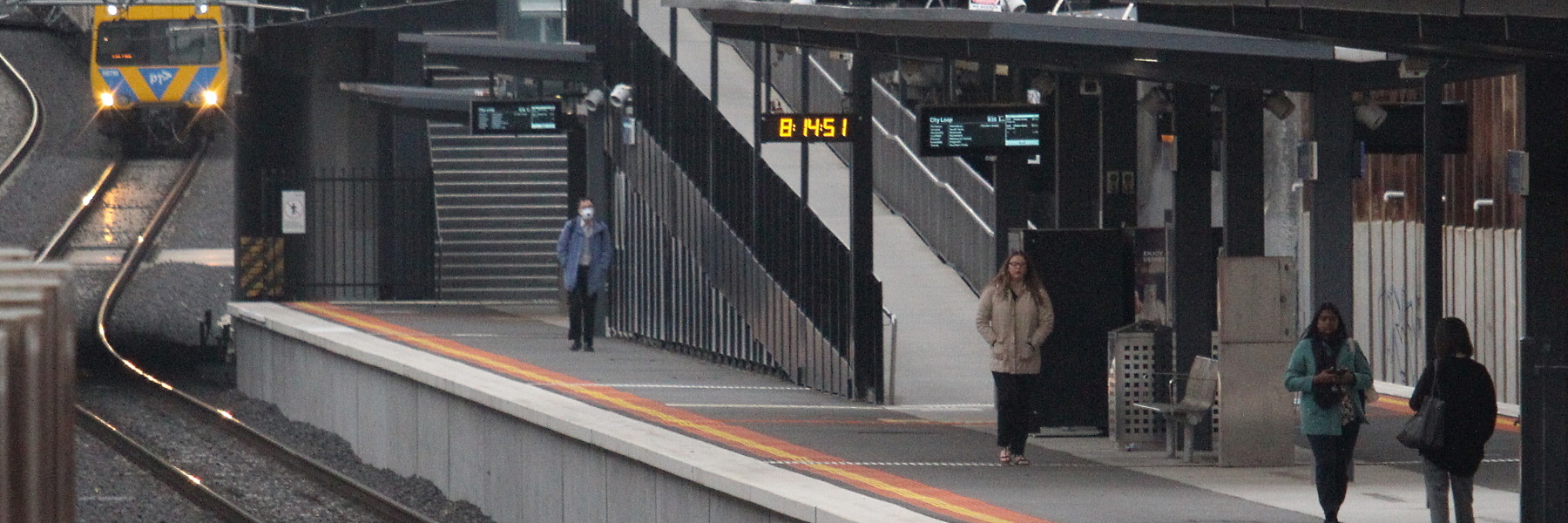It was recently reported that, despite the COVID-19 crisis, and large numbers of people staying at home, Victoria’s public transport network is still carrying about 200,000 trips per day.
How does this compare to normal?
I’ve taken last year’s State Budget targeted annual trips for 2019-20, and used previous rail patronage data indicating each weekday is about 17.19% of weekly patronage. Assuming every week is the same (which it isn’t), this gives us a rough estimate of a “typical” weekday.
| Mode | Targeted trips 2019-20 | Estimate per weekday |
| Metropolitan buses | 119,500,000 | 392,881 |
| Regional buses | 14,300,000 | 47,014 |
| Metropolitan trains | 246,200,000 | 809,433 |
| Regional trains and coaches | 23,200,000 | 76,275 |
| Trams | 208,100,000 | 684,171 |
| TOTAL | 611,300,000 | 2,009,774 |
Note: this is trips, not passengers. Each passenger would typically make multiple trips per day, often using multiple modes.
So then, based on that rough calculation, a mere 200,000 trips per weekday right now, presuming it’s measured the same way, is down about 90% on normal numbers.
200,000 trips in these difficult times might be more you might think. Apart from shopping trips mentioned in the article (essential for some people) this perhaps points to the common assumption that All PT Users Are White-collar CBD Commuters Who Can Work From Home being quite wrong.
How much lost revenue is that?
The tram and train operators mostly get paid for running services and project works, but they also get a share of fare revenue.
The PTV Annual Report for 2018-19 says total fare revenue for the year (plus a few other minor revenue streams) was $982 million. If that revenue is down 90%, that’s down about $17 million each week.
The report also says that of that revenue, about $620 million was distributed to the transport operators, though it doesn’t specify how much went to each. That’s about $12 million per week.
So if fare revenue is down 90%, it’s costing them collectively about $11 million per week.
The State Government view seems to be that a full service will keep running. This is partly because thankfully COVID-19 has not affected staff availability. It’s also partly as a way of avoiding further economic impacts from standing down large numbers of transport workers.
And of course running the full service helps support essential workers who have to commute do continue to do so, and help with staff and passenger safety, given the system has plenty of spare capacity right now.
I don’t recall a pandemic clause being in the contracts. But given the cost to the private operators, I wouldn’t be surprised if there’s some kind of deal in the works.
- Reminder: You can pause a Myki Pass


8 replies on “PT patronage is down 90%”
Good point about the reasons for running a full service. Living in the CBD I notice lots of people using the Elizabeth St trams to get from Flinders St Station to their jobs in the hospital complex around Haymarket so those routes are certainly supporting key workers in the fight against the virus. Also, for social distancing to be maintained it makes sense to have way more trams than strictly needed, so they run with few passengers who can easily space out.
I wonder if the drop in revenue is enough for some of the public transport operators to be eligible for JobKeeper.
I imagine punctuality has also improved – they may get a bonus (or at least fewer fines) for this.
While there are empty trams or trams with one or two people on them passing here constantly, it was interesting to see Chapel Street trams with normal looking loadings of people who can’t work from home, don’t have cars, do have appointments and need to shop.
I have read several articles about what the eventual return to normal will look like and how it will take to get the patronage numbers back to normal (if in fact they ever do). Some have commented that they never will and people will avoid PT for some time. I am not sure about this and liken PT to visiting the supermarket. The cost and inconvenience of driving will push people back to PT (maybe gradually). People still visit supermarkets where so much is touched by so many people and I am not talking about baskets and trolleys which are now cleaned. Things about each box you pickup and how many people have done the same before you. However we still visit and have been in droves. Once they relax some distancing rules we will still be lined up waiting to process our purchases in much the same way we wait on a train or bus.
@xulon see this post from a few weeks ago for punctuality: https://www.danielbowen.com/2020/03/28/covid-19-punctuality-up/
I’m still commuting daily to Geelong. Numbers travelling in the counterpeak direction are also well down – I have managed private carriages sometimes, maybe even a private half-train! Conductors are not checking tickets, or even patrolling the carriages.
BTW I had a recent win on review by PTV where I’d been charged over the daily off-peak cap to Geelong after taking an additional evening trip within Zone 1 – as well as getting the overcharge refunded, I got a $10 bonus for my troubles!
[…] hearing public transport patronage has climbed slightly since a few weeks ago. Instead of being 90% below normal, it’s now “only” 85% below normal, with around 300,000 trips per […]
[…] in Melbourne, patronage has recovered to about 20% of normal levels. We are told adequate physical distancing requires the system to run […]